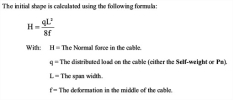Deformation of cables
In a cable, it is possible to define an initial deformation which is in equilibrium with a specified load.
This initial deformation is specified in the properties of the nonlinearity.
For example, the initial shape of the cable can be in equilibrium with its own weight.
However, this presents difficulties in the interpretation of the results for the deformation. After all, in older versions it was only possible to ask the deformation relative to the deformed cable. The deformation needed to be summed.
We consider the example of a cable with a round full section (diameter 50 mm) of steel S235 and a length of 10 m. This we will give an initial cable line calculated from its own weight (0.151 kN/m) and pre-tension (N = 33.844 kN). This gives an initial deformation f in the middle of the cable of 55.7 mm.
We entrust this cable now with a distributed load of 0.1 kN/m, which is smaller as the self weight. This provides the following results for the deformations.
This is the deformation that is given if in the properties window the option 'Structure' is put on 'Deformed' or 'Initial' or 'Section'. These were the only three options available in versions prior to SCIA Engineer 2008.1 for showing the results of the deformations.
This result is difficult to interpret because it looks like the cable bends upward. This is obviously not the case. The deformation which is obtained here, should be in fact added to the initial deflection of the cable. Because the load is less than the load that is specified in the properties of the nonlinearity, the deformation presents a negative deflection, as the global deformation is smaller than the initial deformation under its self weight.
Therefore, it is also possible to see the global deformation, which now shows the actual deflection of the cable (this option is available since SCIA 2008.1):
This global deformation is therefore equal to the sum of the initial deformation and the deflection with respect to this initial deformation.
Because the load of 0.1 kN/m, which is put on the cable, is smaller than the load of its own weight (0.151 kN/m), specified in the properties of the nonlinearity, this global deformation will thus be smaller than the initial deformation of 55.7 mm.
So the global deformation gives the result that is clearest to interpret. It is simply the total deformation of the cable under the influence of the applied load (calculated from the initial deflection line).


_thumb_0_100.jpg)
_thumb_0_100.jpg)
_thumb_0_100.jpg)
_thumb_0_100.jpg)